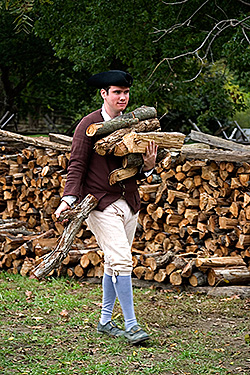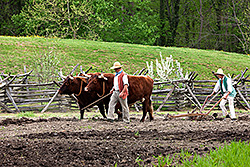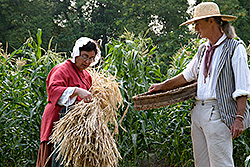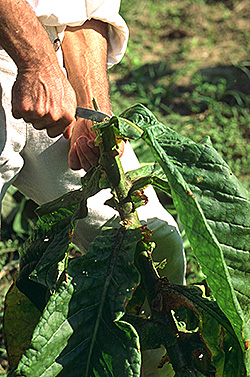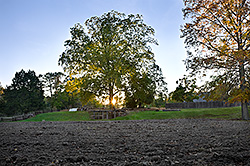Page content
Historic Farming
Seasonality
Agriculture is an ancient dance between man and nature, with all its cooperation and conflict. It is the classic relationship whereby mankind’s artificial agenda confronts nature’s capriciousness. Seasonality is but one of nature’s forces that the farmer must respond to in a skilled and knowledgeable way if he or she is to be successful. The following is a basic review of a monthly calendar.
January
Seated into the winter season, the colonial Chesapeake planter begins the new year with resumption of maintenance and preparation activities. This is also the time to catch up on tasks that were put off during the more demanding seasons. These might include tool, equipment and facilities construction or repair like fence-mending, ditch-digging, road repair, outbuilding repair, orchard pruning, firewood-making, or new ground clearing. Residual processing activities also were continued through the early months of the new year. Examples would be tobacco-prizing, wheat-threshing, fiber-processing, and butchering as weather allowed.
February
January activities continue into February, but some soil is dry enough to work, and some planters already are sowing early tobacco seedbeds. New orchard trees are sometimes set in February. As a result of timber-clearing, large amounts of firewood were carted to urban markets like Williamsburg and Yorktown.
March
March is often the transitional month as winter gives way to spring-like weather. This is a common month to sow tobacco seedbeds, plant oats, and sow flaxseed in the Chesapeake. Fields can be plowed in preparation for spring crops if dry enough conditions occur. By the end of March traditional winter activities are being replaced by those requiring longer days and warmer temperatures. March is a month of lambing and calving.
April
While April is traditionally a wet month, it is also one for plowing and planting. Corn traditionally goes into the ground in April. Oats are in by now. Weeding of tobacco “plant patches” is ongoing.
May
May is another transitional month often beginning with mild spring temperatures turning to hot dry conditions. This can affect the warm weather crops that are planted in May, like tobacco and cotton. Soil temperatures are generally good for quick germination of corn, and garden crops like sweet potatoes, melons, squash and beans. Early-arriving tobacco ships begin leaving the Chesapeake for England. laden with last year’s tobacco crop.
June
Replanting of corn and tobacco occurs in early June. By mid-month through early July the wheat is harvested and stored for threshing. Early-planted corn is large enough to receive its last weeding by the end of June. Tobacco continues to be carefully weeded. Tobacco now receives labor priority with weekly inspections of rapidly expanding leaves for worm and insect damage. Plants are topped in June, ushering in the additional task of suckering.
July
Summer is in full affect throughout July. High heat and humidity, in addition to periodic rainfall, benefits tobacco, corn and weeds. But periods of drought can also occur in the Chesapeake, stressing plants, livestock, and farmers. Corn tassels no longer needed for pollination and their stalk above the ear can be harvested (“topped”) for winter fodder. Oats are dry and ready for mowing.
August
Tobacco is maturing through August, requiring less cultivation but active monitoring of the expanding insect populations. By the end of this traditionally hot and dry month, corn and tobacco have grown to their maximum size and are beginning to dry naturally. Cultivation gives way to harvest. Corn blades and tops are gathered for fodder. Early fall garden crops can be sown and watered.
September
This third transition month is generally devoted to harvesting activities as the weather begins to moderate. Fall weather approaches by month’s end. Corn blades are pulled, tied and cured for fodder. The last tobacco plants ripen and are cut and hung for curing. Plowing and harrowing for sowing wheat commences.
October
Winter wheat is often sown in the month of October. Corn ears can be dry enough to begin harvesting. Early harvested tobacco is cured and ready for further processing. Tobacco inspection warehouses are open from now through early August of next year. Fallow (no crop sown) plowing can be done. Apples are harvested and cider is made.
November
Corn continues to be taken from the fields, is shucked and stored in corn houses or cribs. Cured tobacco is stripped, sorted, tied and bulked for prizing in hogsheads. Tobacco is taken to inspection warehouse. If time allows, wheat can be threshed. During this season of deteriorating weather, work proceeds as weather allows.
December
Temperatures are often cool enough to commence butchering of livestock, especially pork and beef.. Planters strive to have all their corn secured by Christmas, and hope to have their tobacco packed by year’s end. However, if moist weather allows, tobacco continues to be processed through the early months of the following year. If the weather is dry, wheat must be threshed, cleaned, and stored or shipped before warm days reappear. Winter season activities commence.

